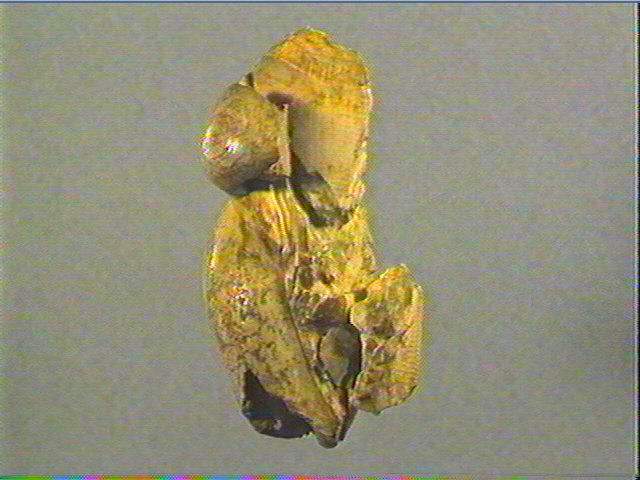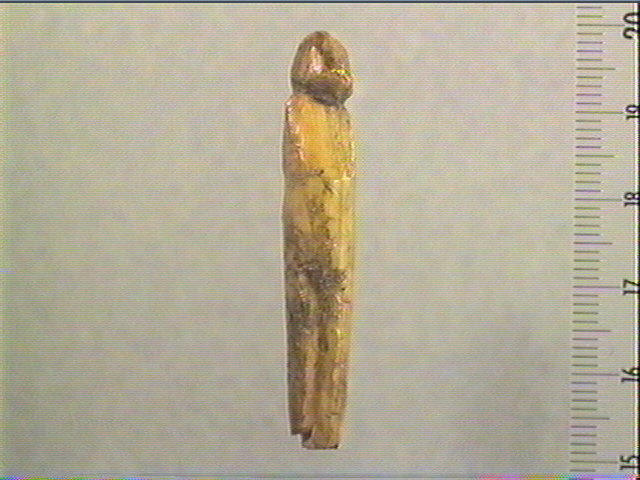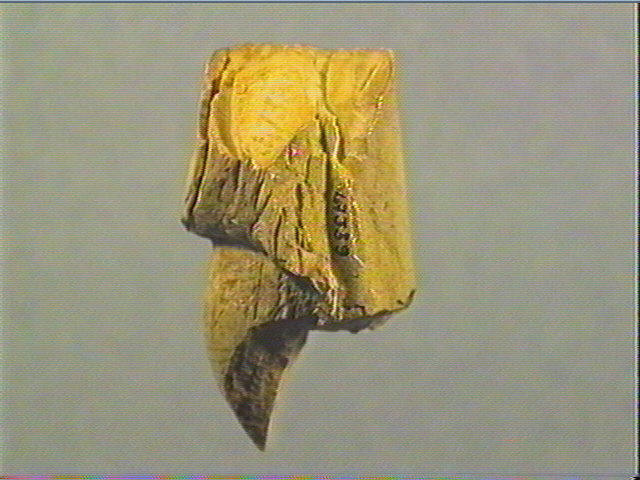Environ 1200 résultats pour « Ivoire »
-

Ivoire
L'ivoire est une substance dure, blanche, opaque qui est la matière principale des dents et des défenses d'animaux comme l'éléphant, l'hippopotame, le morse, le narval, le cachalot, le phacochère. En France le mot ivoire s'applique préférentiellement (et commercialement) à l'ivoire d'éléphant ou de mammouth. Depuis la préhistoire, l'homme taille et sculpte l'ivoire. Avant l'introduction du plastique, l'ivoire était utilisé pour fabriquer des objets usuels : boules de billard, touches de piano, boutons, éventails, manches de couvert, reliures de livres.
-

La dame de Brassempouy ; La dame à la capuche
-
- Domaine(s) :
- Archéologie
- Art mobilier
- Ivoire
- Paléolithique
- Sculpture
-
- Sujet représenté :
- Coiffure
- Femme
- Tête humaine
-
-

L'ébauche
-
- Domaine(s) :
- Archéologie
- Ivoire
- Paléolithique
-
- Sujet représenté :
- Homme
- Jambe
- Pied (anatomie humaine)
- Pénis humain
-
- Datation :
- Gravettien
-
-

-
- Domaine(s) :
- Archéologie
- Art mobilier
- Ivoire
- Paléolithique
-
- Désignation :
- statuette ; incisive (cheval)
-
- Sujet représenté :
- Femme
- Tête humaine
-
-

-
- Domaine(s) :
- Archéologie
- Art mobilier
- Ivoire
- Paléolithique
-
- Désignation :
- statuette ; pendeloque
-
- Sujet représenté :
- Femme
-
-

La figurine à la ceinture
-
- Domaine(s) :
- Archéologie
- Art mobilier
- Ivoire
- Paléolithique
-
- Sujet représenté :
- Homme
- Pénis humain
-
-

La figurine à la pèlerine
-
- Domaine(s) :
- Archéologie
- Art mobilier
- Ivoire
- Paléolithique
-
- Datation :
- Gravettien
-
-

La vénus de Brassempouy ; La poire
-
- Domaine(s) :
- Archéologie
- Art mobilier
- Ivoire
- Paléolithique
- Sculpture
-
- Sujet représenté :
- Femme
-
- Datation :
- Gravettien
-
-

-

La fillette ; La poupée
-
- Domaine(s) :
- Archéologie
- Ivoire
- Paléolithique
- Sculpture
-
- Sujet représenté :
- Fille
-
- Datation :
- Gravettien
-
-

L'ébauche de poupée
-
- Domaine(s) :
- Archéologie
- Art mobilier
- Ivoire
- Paléolithique
-
- Sujet représenté :
- Femme
-
- Datation :
- Gravettien
-
-

-
- Domaine(s) :
- Archéologie
- Art mobilier
- Ivoire
- Paléolithique
-
- Désignation :
- statuette | Vénus
-
- Sujet représenté :
- Femme
-
- Datation :
- Gravettien
-
-

-
- Domaine(s) :
- Archéologie
- Ivoire
- Paléolithique
-
- Désignation :
- baguette
-
- Datation :
- Aurignacien
-
-

-
- Domaine(s) :
- Archéologie
- Ivoire
- Paléolithique
-
- Désignation :
- baguette
-
- Datation :
- Magdalénien
-
-

-
- Domaine(s) :
- Archéologie
- Ivoire
- Moyen Âge
- Sculpture
-
- Désignation :
- tau | tau de Jumièges
-
- Sujet représenté :
- Chien
- Crosse épiscopale
- Femme
- Homme
- Livre (document)
- Oiseau
-
- Datation :
- XIe siècle
-
-

Netsuké en ivoire représentant un haricot et des coquillage…
-
- Domaine(s) :
- Asie de l'Est
- Costume
- Ethnologie
- Ivoire
-
- Datation :
- XVIIIe siècle
-
-

-
- Artiste(s) :
- Anonyme
Le sculpteur de masque
-
- Domaine(s) :
- Asie de l'Est
- Costume
- Ethnologie
- Ivoire
-
- Sujet représenté :
- Homme
- Masque
- Sculpture
- Station assise
-
- Datation :
- XVIIIe siècle
-
-

Fukura Suzume
-
- Domaine(s) :
- Asie de l'Est
- Costume
- Ethnologie
- Ivoire
-
- Sujet représenté :
- Oiseau
-
- Datation :
- XVIIIe siècle
-
-

Fukura Suzume
-
- Domaine(s) :
- Asie de l'Est
- Costume
- Ethnologie
- Ivoire
-
- Sujet représenté :
- Moineau
-
- Datation :
- XIXe siècle
- XVIIIe siècle
-
-

-
- Artiste(s) :
- Anonyme
-
- Domaine(s) :
- Ethnologie
- Ivoire
-
- Désignation :
- coffret
-
- Datation :
- XIIIe siècle
- XIIe siècle
-
-

-
- Artiste(s) :
- Anonyme
-
- Domaine(s) :
- Ethnologie
- Ivoire
-
- Désignation :
- coffret
-
- Sujet représenté :
- Oiseau
-
- Datation :
- XIIIe siècle
- XIIe siècle
-
-

-
- Artiste(s) :
- Anonyme
-
- Domaine(s) :
- Asie de l'Ouest
- Ethnologie
- Ivoire
- Médecine
-
- Désignation :
- boîte à médicaments
-
- Sujet représenté :
- Jésus de Nazareth
- Livre (document)
- Station assise
- Tunique
-
- Datation :
- VIe siècle
-
-

-
- Artiste(s) :
- Anonyme
Mariage d'Henri II et de Catherine de Médicis
-
- Domaine(s) :
- Ethnologie
- Histoire
- Ivoire
-
- Sujet représenté :
- Bénédiction
- Catherine de Médicis
- Chien
- Femme
- Henri II de France
- Homme
- …
-
- Datation :
- XIXe siècle
-
-

-
- Artiste(s) :
- Anonyme
Combat de saint Michel
-
- Domaine(s) :
- Croyance
- Ethnologie
- Ivoire
-
- Sujet représenté :
- Ange
- Combat
- Flamme (combustion)
- Michel (archange)
- Satan
- Trompette
-
- Datation :
- XIXe siècle
-
-

-
- Artiste(s) :
- Anonyme
Saint écrivant
-
- Domaine(s) :
- Croyance
- Ethnologie
- Ivoire
-
- Sujet représenté :
- Livre (document)
- Saint
- Station assise
- Écritoire
-
- Datation :
- XIXe siècle
- XVIIIe siècle
-
-

-
- Artiste(s) :
- Anonyme
La Mort de saint Benoît
-
- Domaine(s) :
- Croyance
- Ethnologie
- Ivoire
-
- Sujet représenté :
- Benoît de Nursie
- Bénédiction
- Chasuble
- Gloire (ornement)
- Prêtre catholique
- Tombeau (architecture)
-
- Datation :
- XIXe siècle
-
-

-
- Artiste(s) :
- Anonyme
-
- Domaine(s) :
- Ethnologie
- Ivoire
-
- Désignation :
- plaque
-
- Sujet représenté :
- Arbre
- Femme
- Nu (genre artistique)
-
- Datation :
- XIXe siècle
- XVIIIe siècle
-
-

-
- Artiste(s) :
- Anonyme
Saint Jacques
-
- Domaine(s) :
- Croyance
- Ethnologie
- Ivoire
- Sculpture
-
- Sujet représenté :
- Barbe
- Chapeau
- Coquille Saint-Jacques
- Homme
- Jacques de Zébédée
- Livre (document)
-
- Datation :
- XIXe siècle
- XVIIIe siècle
-
-

-
- Artiste(s) :
- Anonyme
-
- Domaine(s) :
- Ethnologie
- Ivoire
-
- Désignation :
- râpe à tabac
-
- Sujet représenté :
- Femme
- Feuille
- Fruit (botanique)
-
- Datation :
- XVIIIe siècle
-
-

-
- Artiste(s) :
- Anonyme
-
- Domaine(s) :
- Ethnologie
- Ivoire
-
- Désignation :
- râpe à tabac
-
- Sujet représenté :
- Cygne
- Femme
- Fleur
- Vase (récipient)
-
- Datation :
- XVIIIe siècle
-
-

-
- Artiste(s) :
- Anonyme
-
- Domaine(s) :
- Ethnologie
- Ivoire
-
- Désignation :
- râpe à tabac
-
- Sujet représenté :
- Arbre
- Couple (droit et sociologie)
- Danse traditionnelle
- Feuille
- Fleur
- Homme
-
- Datation :
- XIXe siècle
- XVIIIe siècle
-
